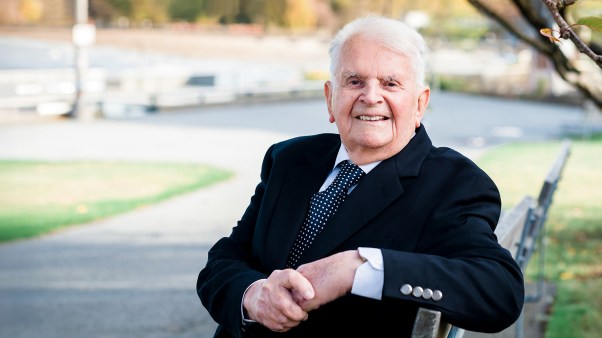David Foster Wallace’s famous commencement address “This Is Water” begins with a story about fish:
There are these two young fish swimming along, and they happen to meet an older fish swimming the other way, who nods at them and says, “Morning, boys, how’s the water?” And the two young fish swim on for a bit, and then eventually one of them looks over at the other and goes, “What the hell is water?”
Sometimes the things right in front of us are the hardest to see. Like gravity or the cultural belief systems we inhabit, there are, as Wallace put it, “obvious, ubiquitous, important realities” all around us—“hidden in plain sight.” The more fundamental they are to our daily experience, the easier they are to overlook.
Philosophers David Baggett and Jerry L. Walls want us to notice one of those overlooked realities: morality. Notice the horror we feel toward sexual violence. Or our admiration for self-sacrifice. Or our indignation when the powerful trample the weak. Or our relief when justice is done.
In their book The Good, the Right, and the Real: Is Value a Fact?, Baggett and Walls want us to ask, What exactly is this moral water we swim in?
Over 40 years ago, philosopher Robert Adams compared moral arguments for God’s existence to an abandoned farm. What was once a popular family of arguments producing a ripe harvest fell on hard times. But since then, renovation has been underway, and a string of philosophers have brought the farm back to life.
Baggett and Walls are two leading figures in this contemporary rebuilding project, and their series of four books analyzing moral arguments for God has been a service to Christian apologists and curious skeptics alike.
Their project began with Good God (2011), a defense of God as the foundation of morality. Next came God and Cosmos (2016), a critique of secular attempts to ground morality in alternative sources of authority. Then, the authors followed up with The Moral Argument (2019), a history of moral arguments across Western thought.
The Good, the Right, and the Real represents the final installment in this series. Though chronologically it comes last, logically it goes first. The earlier books assume objective morality—that some things are right or wrong, good or evil, regardless of human opinion. This one defends the existence of objective morality.
Moral realism is the philosophical term for the view that objective morality exists. The authors’ definition has four distinct features. First, moral judgments are “truth-apt” (meaning that statements like “Murder is wrong” are capable of being true or false). Second, some moral judgments are true (murder is wrong). Third, the truth of these judgments does not depend on human attitudes (murder is wrong even if people think it’s not). And fourth, at least some clear moral truths are known.
Without this foundation, moral arguments for God’s existence can’t get off the ground. But how do we know whether moral realism is true? We can’t run lab tests on justice. Nor can we dissect the human brain and find “goodness” inside. We need a different set of tools.
Secular philosophers Terence Cuneo, Russ Shafer-Landau, and John Bengson have approached the question by identifying moral “data” in need of explanation and suggesting we let the best theory win. For example, one’s moral theory should be able to explain why there is both widespread agreement about some moral issues and widespread disagreement about others. It should be able to explain why moral judgments are thought to motivate or direct our actions. And it should be able to explain why moral demands apply regardless of what we think or feel.
Baggett and Walls agree with these criteria. They argue that moral realism, unlike its competitors, makes the best sense of what we actually experience. But as they remind us, “Moral theory is hard … and no single volume will clear everything up.” Though progress is possible, don’t expect knockout blows.
This intellectual humility is consonant with their previous books. They don’t overpromise. They don’t feign certainty. Their conclusions are modest, and their tone is winsome. They respect other thinkers and take their arguments seriously. It’s clear their goal is not to win but to woo.
Baggett and Walls spend much of The Good, the Right, and the Real considering and critiquing the main alternatives to moral realism: error theory, expressivism, constructivism, and sensibility theory.
Error theory is the view that our moral language tries to describe real facts, but there just aren’t any. So, for example, when we say, “Murder is wrong,” we’re wrong, not because murder is right but because murder is … nothing. It’s neutral. Though we speak as if good and evil exist, we are mistaken; morality is a noble lie.
The philosophical price for holding this view is steep. “It assumes,” Baggett and Walls point out,
that our moral experience—the visceral aversion we have thinking about the Holocaust, our phenomenological antipathy to cruelty, our abhorrence of mindless barbarism or rapacious greed, the deep satisfactions of morality we are capable of feeling, our ravenous hunger to see justice done—is systematically misleading.
In other words, it denies that the water exists at all.
Expressivism, like error theory, contends that there are no true moral claims. But instead of saying all moral claims are false, it says there aren’t any genuine moral claims to begin with. That’s because, on this view, moral claims aren’t describing reality; they’re merely expressing emotions or prescriptions. For example, “Murder is wrong” is akin to saying, “Boo, murder,” or telling people, “Don’t murder.”
While this theory captures something true—emotions and prescriptions do play a role in our moral experience—it leaves too much unexplained. If morality is reduced to “I don’t like that,” or “Don’t do that,” then why should people comply? The authority—the “oomph,” as philosopher Richard Joyce puts it—is absent. Worse, expressivism seems unable to explain our moral outrage at atrocities. If the Holocaust is only emotionally disturbing but not morally wrong in any objective sense, something vital has been lost.
Constructivism is a middle course between moral realism and expressivism. It holds that morality exists but isn’t discovered. Instead, it’s created—by individuals, societies, idealized rational agents, or hypothetical social contracts. The basic idea is that something is moral simply by virtue of people or groups endorsing it.
Every version of constructivism is flawed, even if, as Baggett and Walls argue, some are more flawed than others. If individual moral views determine what’s right, then disagreement entails incoherence. One person might think the Holocaust was right while another might think it was wrong—but they can’t both be correct. The belief that societies determine what’s right hardly fares any better. Morality can’t vary with the shifting winds of cultural consensus, or else we could conclude that slavery was right when most supported it but wrong when most opposed it.
Constructivist theories that replace real people with “ideal observers” or social contracts try to improve upon these weaknesses. They ask, for example, what fully informed people would approve, morally, if you stripped away all their biases. Ultimately, however, they fail to secure binding moral authority. Why obey the dictates of nonexistent entities?
Sensibility theory—at least the version that’s in conflict with moral realism—suggests that our feelings themselves constitute morality. Our emotional response to witnessing a child bullying another to tears—the anger toward the bully and the sympathy for the victim—makes it true that the bullying is morally wrong.
Unfortunately, if morality is reduced to feelings, then morality is arbitrary. Should our emotional reaction to (say) rape change, then rape could be judged morally right.
Other sensibility theorists take a different approach, suggesting that feelings point to reality rather than constitute it. On this view, Baggett and Walls explain, “Emotions may be and plausibly are simply signaling capacities for apprehending moral truths.” Our feelings of revulsion toward injustice help alert us to the wrongness of it; they aren’t what make unjust actions wrong. This view complements moral realism, in that both theories credit our emotions with helping us recognize moral truths.
This brings us to one of the book’s surprising twists.
In the final chapter, Baggett and Walls conclude their rigorous philosophical treatment with a turn from philosophy. After exposing the weaknesses of the alternatives to moral realism and offering a smattering of arguments in support, they take off their philosopher hats and emphasize the experiential nature of morality, both in literature and in the real world.
“Moral goodness, like beauty, carries with it something ineliminably experiential,” they write, “and recognition of this fact makes it all the more appropriate that any argument for robust moral realism should include elements that go beyond the purely logical and abstract.”
In Flannery O’Connor’s short story “Good Country People,” for example, a young woman is content in her moral skepticism until a conniving Bible salesman betrays her in a moment of vulnerability. Though she doesn’t believe in right and wrong, she accuses him: “You’re a Christian! … You’re a fine Christian! You’re just like them all—say one thing and do another. You’re a perfect Christian, you’re …” The man replies, “I hope you don’t think that I believe in that crap! I may sell Bibles but I know which end is up and I wasn’t born yesterday and I know where I’m going!”
The woman’s abstract theory about the nature of morality was safe until it collided with reality.
Something more powerful than philosophical argumentation is on display here. You can’t argue someone into seeing the Grand Canyon’s beauty. But you can point and say, “Look.”
Perhaps morality is like that. Encounters with both betrayal and loyalty, selfishness and self-sacrifice, greed and generosity—these are the experiences that shape our moral views. Philosophy simply refines them.
This means that weighing the validity of moral realism is never merely an academic exercise. It’s one of the most urgent and consequential tasks we can undertake.
If moral realism is false, then our deepest moral convictions—about justice and kindness, oppression and cruelty—are just preferences. How we treat others is negotiable. The Holocaust isn’t evil, and the abolition of slavery isn’t progress. All this leaves victims of abuse, persecution, and exploitation not only with the pain of their suffering but also with the silence of a universe incapable of calling it wrong.
But if moral realism is true—if there really is a moral structure to the universe independent of human opinion—then the picture changes completely. Our longing for justice is not naive. Charity and love are truly good, and cruelty and deceit are truly bad. Each human being has inestimable worth.
In this way, The Good, the Right, and the Real is not only a philosophical argument but also a gentle plea for moral attention. A plea, in other words, to listen to the inner voice telling us that some things are genuinely noble and some genuinely evil—to consider that this voice might not be a delusion or an evolutionary leftover but an insight into the nature of reality. This book is an invitation to notice the water.
Noah M. Peterson is a philosophy of religion graduate student at the University of Birmingham and the editor of a think tank based in Washington, DC.


















